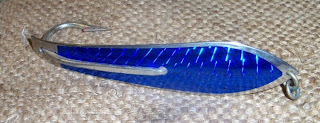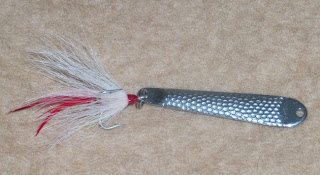The Rasch Outdoor Chronicles: Spoons: They're Not Just for Cereal!
© 2010 Albert A Rasch™ and
The Rasch Outdoor Chronicles
$g&m f9bd 45kd q!?5.
"But do tell: A spoon in a bird's chest?
That is too damn weird - whatup with that?"
Couldn't resist it, honest!
After Holly's comment on the spoon in the pelican's chest, I promised to have a short discussion on the lures used for fishing that are called spoons.

My near-shore spoon selection:
Dressed nickel spoon, dressed nickel Krocodile, brass Krocodile, dressed nickle KastMaster, smaller dressed nickle KastMaster, hammer finished Hopkins spoon, brass Clark spoon w/swivel, and nickel Clark spoon.
To those folks that don't fish, it might seem a little strange when fishermen talk in their peculiar jargon. Plugs, streamers, midges, spinners, jigs, flies and spoons are all artificial lures used in the attempt to fool a fish into striking and getting itself impaled on a hook.
 Who invented the spoon,
or the history of fishing spoons according to Albert.
Who invented the spoon,
or the history of fishing spoons according to Albert.
My guess is that this all started sometime in the past when a Viking lopped the arm off of some other guy who was having breakfast on the deck off of his lodge. The spoon flew out of the now detached hand and fell into the water, whereupon the two were amazed when a fish sped by, and struck at the twisting, flashing spoon as it dropped into the depths.

That's why I think fishing spoons are probably among the oldest manufactured lure. When they saw that, they probably figured out that a shiny piece of metal might just get a hungry fish to strike. So they headed over to the smithy, fight and arm forgotten, and told the smith to hammer out a thin, oval shaped, concave dish of metal and attach a forged hook to it. Eureka, the spoon was born!

Spoons are generally either silver or brass in color, and normally come in either a polished, or hammered finish. Spoons wobble or dart depending on the retrieve, and the flashing and sparkling play of light off the body attract fish. There are painted and partially decorated spoons too, but I don't use them much, the nickel and brass ones pretty much working out well enough for me, thank you very much.
 How do you rig a spoon?
How do you rig a spoon?
Spoons do tend to twist and turn, usually in one direction. It's one of the things that makes spoons so attractive to fish. If you don't take the spinning or twisting action into account, you will end up with a spool of badly twisted line that will not retrieve properly, jump off the spool, and become weaker very quickly. Some spoons have a swivel built in to allow them to rotate without affecting the line. If your spoon is without a swivel, you will have to put one on the spoon, or better yet, rig one on the running line.

As I said, there are two ways to accomplish the task. The easiest way is to add a swivel right to the nose of the spoon. If the spoon does not have a split ring attached, you will have to add one. Go with a size larger than you think you need, it won't affect the action; quite the contrary, the larger size allows the spoon to flutter and drop much more convincingly without the drag of the line right at its nose. Next add the swivel to the split ring and call it done.

The way I prefer to do it is the following. I add a split ring to the nose of the spoon just as we did above. But this time add anywhere from twelve to twenty-four inches of leader to the split ring, and then tie the swivel to the leader. If you use Spiderwire, any of the braided lines, or one of those wacky colored lines, this is the only way to go. Fish can see those lines, especially in clear water and will veer off your lure when they catch sight of the line leading away from it! By the way, I only use the Uniknot for all my knots. That will be another post in the near future.

If you are using a light spoon, like the Clark spoons, you have to add a little weight to the rig in order to cast it, or get some depth to in the retrieve. Just add a torpedo sinker, or even an egg sinker above the swivel. Just a reminder, you do this with the second rigging method. I always add a small bead between the swivel and the sinker to protect the knot from any unnecessary abuse from the sinker.

If you are running into some Bluefish, Spanish Mackerels, or gator Seatrout, you may need to use a wire leader. The same rules apply. With spoons costing anywhere from $2.99 to $6.99 for the small to medium sizes, it doesn't take many cut offs to make you use a wire leader! Length can be as short as 2" to as long as 12". Try to use the finest wire you can find, and hope for the best! If the bite is hot, it probably won't matter what length the leader is. If the fish are running shy, you may only be able to use a short leader.
Maintaining your fishing spoons.
Like everything else, your fishing gear needs a little maintenance in order to last a good long time. The first thing I do at the end of the fishing day is rinse everything off with fresh water. Rods, reels, and lures get a good washdown and dry before being put up.
Spoons though, get pretty beat up with time. They get dragged across the bottom, banged against rocks, swung into pilings; after a while, they lose their shine. The first thing to try is a good old Brillo pad. That will usually get your nickel colored spoons shiny again, or at least less dull than they were. Brass lures get the same treatment, but then I finish them with Brasso for that extra shine. Wash them well with dish detergent when you're done, you don't want to leave any soap or polish residue on the lure.
If your lures are pretty bad off, or maybe you found one that is beat up bad, you can refurbish it with some elbow grease. Some fine wet/dry sandpaper and a buffing wheel on your grinder will bring a junker back to like new condition. And as I mentioned before, with the prices as high as they are getting, it doesn't take too many yard sale finds to make it worth your while.
I have a couple of old spoons that I need to refurbish and when I do, we will cover it here.
Best Regards,
Albert A Rasch™
Member:Kandahar Tent Club
Member:
Hunting Sportsmen of the United States HSUS (Let 'em sue me.)
The Hunt Continues...
Search word list:
Fishing with spoons, how to fish with spoons, rigging spoons for fishing, Hopkins spoons, clarke spoons, wire leaders and spoons, spoons for fishing, bucktails on spoons, circle hooks on spoons, rigging spoons, how to rig a spoon, best spoons for fishing, fishing in florida, hooked bird
Read more...











